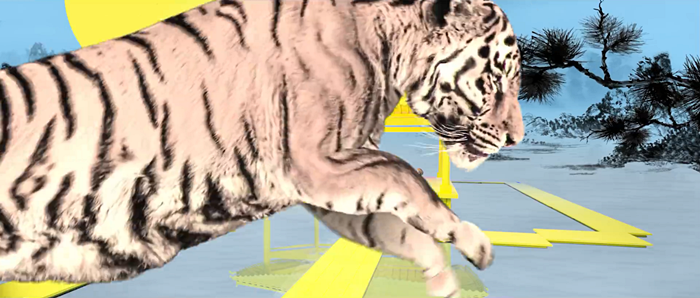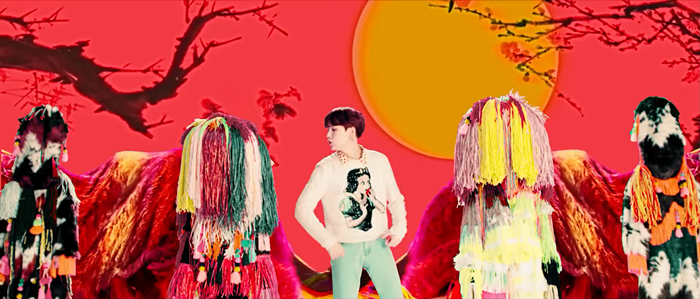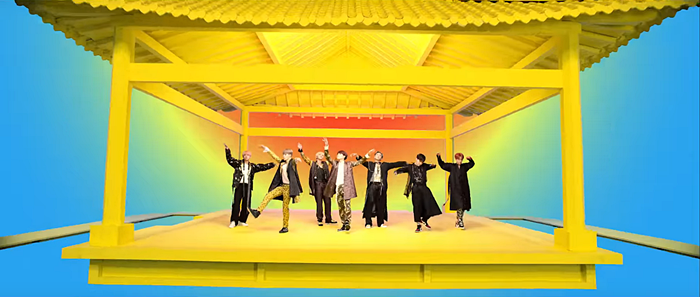
The pop group BTS releases its extended album 'Love Yourself: Answer' on Aug. 24.
By Jung Joori, Lee Seo Yoon and Lee Hana
Photo and video = Big Hit Entertainment
BTS's latest compilation album "Love Yourself: Answer" is rewriting the history of Korean pop.
Since its release on Aug. 24, the album has sold a total of 185,000 copies as of Aug. 30. This number includes sales of 141,000 offline, physical copies. As of Sept. 2, the album hit the No. 1 spot on the Billboard 200 albums chart in the U.S., too.
"Idol" is the album's biggest hit. The song incorporates gqom, a style of house music from South Africa, as well as beats and sounds from traditional Korean gugak folk music. The music video is a fusion of tropical landscapes and Korean imagery.
Below are some representative Korean motifs to look for in the music video.
The tiger, a symbol of Korea

A tiger leaps through one of the scenes in BTS' recent music video hit 'Idol.'
The tiger, which makes a dramatic appearance in the music video and in the 40-second teaser, is a recurring motif in Korean art and heritage. This majestic creature was considered to be a brave and sacred animal since the olden days, and can be found in folk art, folktales and proverbs.
Tigers are beloved to this day. The tiger was a mascot for the PyeongChang 2018 Olympic and Paralympic Winter Games, as Soohorang, the animated white tiger.
Bukcheong Saja Noreum, the lion folk dance

A modernized version of the Bukcheong Saja Noreum, a type of folk dance inspired by lions, is showcased in the BTS music video 'Idol.'
In the music video, you can also catch a glimpse of life-sized, masked lion puppets dancing to the BTS hit. These "lions" are based on the Bukcheong Saja Noreum, a type of traditional folk performance inspired by lions.
This performance originates in Bukcheong-gun County in Hamgyeongnam-do Province, in what is today North Korea. This masked ritual was staged during Jeongwol Daeboreum, the day of the first full moon of the lunar year. At this time, villagers would dance wearing lion masks as a way to ward off bad spirits and bring peace to the land.
Traditionally, these lion masks are brown in color, but in the music video, the producers jazzed up the masks to match the song's African roots.
Bongsan Talchum, the masked dance

Some of the dance moves in the BTS music video 'Idol' incorporate choreography used in Bongsan Talchum, a traditional masked play and dance.
You can spot other traditional influences in the music video's choreography, too. The move where the members spread their arms and raise each arm with a bounce of the shoulders is one that's inspired by the Bongsan Talchum, a traditional masked play and dance.
This type of dance dates back to the Joseon period. This masked performance is characterized by exciting beats and dynamic movements. Filled with satirical dialogue that pokes fun at the ruling class, it was highly popular in Joseon times.
***
BTS has released four albums for the "Love Yourself" series, titled "Wonder," "Her," "Tear" and now "Answer." Through these albums, the group explored the meaning of love.
"Wonder" and "Her" guide us through the process of falling in love, while "Tear" looks at the pain that comes with faking it for love. "Answer," the last in the series, shows the reconciliation between the fake and real selves, and how we can find love along the way.
Through the four-part series, BTS learned to love themselves, while inviting us to join in the celebration. We look forward to what kind of message they will bring us next.
etoilejr@korea.kr